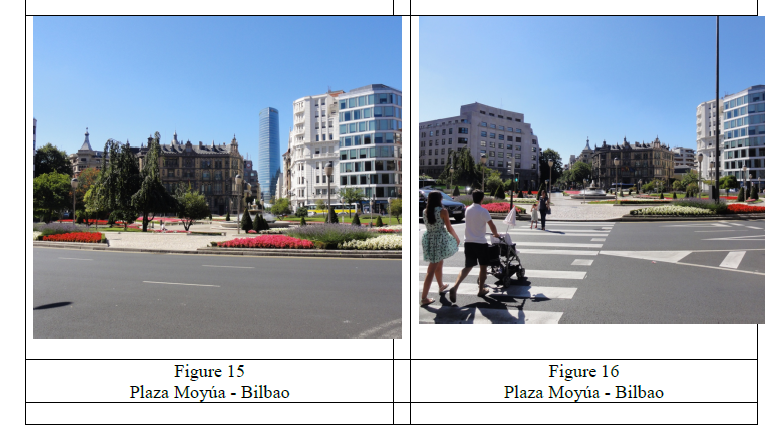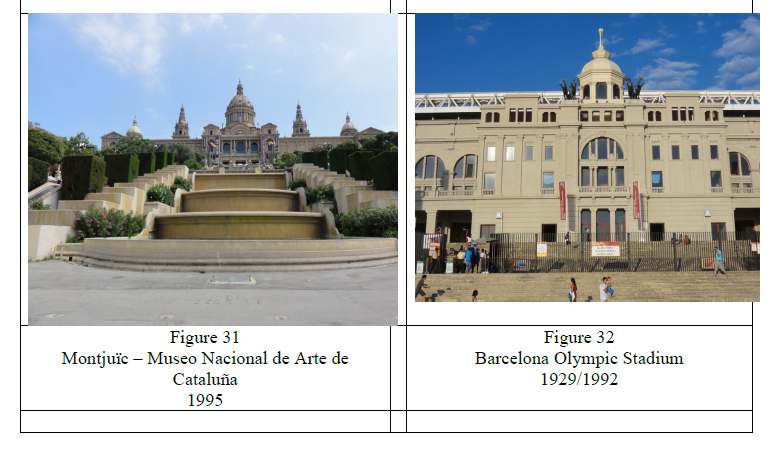SPANISH CULTURE AS REFLECTED IN THE BUILT ENVIRONMENT OF SPANISH CITIES, PART II
UBER, TERRENCE
KENT STATE UNIVERSITY
COLLEGE OF ARCHITECTURE AND ENVIRONMENTAL DESIGN
UBER, DIANE
THE COLLEGE OF WOOSTER
Dr. Terrence Uber
College of Architecture and Environmental Design
Kent State University.
Dr. Diane Uber
The College of Wooster.
Spanish Culture as Reflected in the Built Environment of Spanish Cities, Part II
Synopsis:
By examining public communal gathering spaces in Bilbao and Barcelona, Spain, we have attempted to show that the spaces we use reflect our needs, both functional and aesthetic. The design of these spaces directly affects the behavior of the population, including intergenerational interaction and dissolving boundaries between social classes.
Spanish Culture as Reflected in the Built Environment of Spanish Cities —Part II
Terrence L. Uber, College of Architecture and Environmental Design, Kent State University Diane R. Uber, Department of Spanish, The College of Wooster
INTRODUCTION:This paper is a continuation of the research that was presented at the Hawaii University International Conference on Arts, Humanities and Social Sciences in 2014. The first paper concentrated on the city of Madrid. Part II will focus on the cities of Barcelona and Bilbao. The forms of the urban landscape and architecture are major components of what we think of as culture. The public and private spaces we use reflect our needs, both functional and aesthetic. An understanding of the relationship between the landscape and buildings in a city context can lead to a better understanding of the culture of those who use the spaces.
The field of proxemics, as it relates to design and human behavior, explored by anthropologist Edward T. Hall in his books, The Silent Language, The Hidden Dimension and Beyond Culture, provides stimulus for this paper. Proxemics is defined as the interrelated observations and theories of people’s use of space as a specialized elaboration of culture. People from different cultures often speak different languages, inhabit different sensory worlds and interact according to cultural norms and context (Hall 1990:1-2). Humans can be seen as interlocutors with their environment, and it is essential that we learn to read the silent communications as easily as the printed and spoken ones (Hall 1990:6). According to Hall (1961:10), the silent language is the language of behavior.
The study of cultural communication should also include “how cities are planned and laid out” (Hall 1976: 14). Cities and towns in the Spanish-speaking world generally have the tradition of communal gathering spaces in central plazas or public squares. In addition, many residences as well as public buildings such as museums incorporate courtyards to serve as interior plazas or gathering spaces.
The design of these spaces directly affects the behavior of the population, including intergenerational interaction and dissolving boundaries between social classes. In addition, an analysis of the relationship between the landscape and the buildings in a city context can lead to a better understanding of the culture of the city.
This paper examines public communal gathering spaces in Bilbao and Barcelona, Spain. The Frank Gehry-designed Guggenheim museum is Bilbao’s main attraction. This is an example of modern international architecture, which we examined to ascertain how it functions as an art museum, and how it is incorporated into the Spanish landscape. The Guggenheim and the contemporary riverfront development will be contrasted with the medieval quarter, as well as with the Plaza Moyúa, which contains structures from the late 19th to the mid 20th centuries.
Barcelona is a city with its own sense of style, which is reflected in the buildings and public spaces of virtually every street. The works of Catalan architect Antoni Gaudí – Casa Batlló, Casa Milá, Parc Güell, and La Iglesia de la Sagrada Familia – are signature attractions in Barcelona. La Rambla, a pedestrian mall, is a busy gathering place for both tourists and residents which ends in the Gothic Quarter, while the area known as Montjuïc encompasses numerous museums and public spaces, including the site of the 1929 Barcelona International Exposition and the 1992 Summer Olympics. And the Plaza de los Ángeles is surrounded by the historic Convento de los Ángeles, contrasted with the Museo de Arte Contemporáneo de Barcelona (MACBA).
BILBAO:Bilbao, Spain’s sixth-largest urban area, is in the Basque Country in the north. It was an ironworks industry river town, which has undergone a major transformation in the last 20 years. Bilbao’s main attraction is the Frank Gehry-designed Guggenheim museum (See Image Index, Fig. 1), which is an example of modern international architecture. Placed on the riverfront where industry used to dominate, the entrance (Fig. 2) is reached by descending a long stairway from the street above to the level of the river below – an acknowledgement of the importance of the river in Bilbao’s history. With the momentum created by the Guggenheim, the riverfront (Figs. 3 and 4) has been revitalized for residential use, business and relaxation. The inclusion of parks, café and fountains (Fig. 5) provide public spaces for both visitors and residents to enjoy.
In addition to the Guggenheim Museum, two buildings/complexes have redefined the riverfront in the 21st century. The Iberdrola Tower (Fig. 6) by architect César Pelli is a 40- story structure which dominates the western landscape of the city. With two adjacent residential structures, the modern tower maintains the interface of living and working seen in traditional Spanish cities. Close to the river, there is easy access to the riverside promenades (Figs. 7 and 8), parks and cafes for workers and residents.
The river promenade also features a bridge (Fig. 9) designed by Spanish architect Santiago Calatrava.
This leads to the Isozaki Atea building complex (Fig. 10), positioned along the river between the Guggenheim Museum and Casco Viejo, which was designed to respect the scale of surrounding buildings by balancing two tall, glass towers with lower (6-8 story) brick and stone structures. The complex also incorporates façades (Fig. 11), which were preserved from earlier structures. Residents have easy walking access to retail and business establishments in the center of the city, in addition to the riverside parks.
The different sections of Bilbao provide a unique look at the development of a Spanish city through centuries. The Casco Viejo (Fig. 12) is the medieval area of Bilbao. With narrow streets, there is less evidence of the plazas and open public spaces seen in more modern areas of the city. However the ground-level storefronts and cafes with residential units above provide an intimate setting for locals to meet on sidewalk cafes (Fig. 13). Additional public communal spaces are inserted wherever possible along the streets (Fig. 14), as seen on the street next to the Santiago Cathedral.
Plaza Moyúa (Fig. 15) was originally planned in the 19th century and renovated several times in the 20th century. This large central plaza serves as a hub for hotels, transportation, and businesses for both local residents and visitors. While expertly landscaped with numerous walking paths, the large central plaza/garden is now encircled by multi-lane streets, which may discourage pedestrians from entering it (Fig. 16).
While the city of Bilbao has undergone a major transformation from an industrial river town to a modern city, the development has largely maintained the cultural tradition of combining residential, work and public spaces in the central urban areas.
BARCELONA:The Catalan city of Barcelona, Spain’s second-largest urban area, is a city with its own sense of style, which is reflected in the buildings and public spaces of virtually every street. In Barcelona, the authors visited several Antoni Gaudí-designed spaces: the Church of the Holy Family (Iglesia de la Sagrada Familia) , Parc Güell, Casa Batlló, and Casa Milá (La Pedrera).
The Church of the Holy Family (Fig. 17) was designed as a place of worship but has become a focal point of culture in Barcelona, drawing international tourists and locals to observe, explore and wonder at the creative use of materials and space. Its setting within the city has become decidedly urban, but the park across from the main entrance (Fig. 18) used primarily by local residents and the one on the opposite side of the church directed more toward the tourist trade, fit with the Spanish concept of development to include gathering spaces. Gaudí’s interior (Fig. 19) echoes the trees by creating a forest of abstract columns reaching toward the sky.
Parc Güell (Figs. 20 and 21) was designed to be public communal spaces for a housing development within a park-like setting which never materialized. Although it is located on a very steep hill, it does still function as a gathering place for people of all age groups and for families. There is a large open plaza-like area (Fig. 22), which overlooks the city and numerous walkways (Fig. 23) with areas to rest from the climb; sit and converse; or meditate in the open air. Elaborate structures serve as landmarks throughout the park.
Casa Batlló (Fig. 24) is one of the Gaudí-designed apartment buildings which permit tours in part of the structure to illustrate the original home design. An integral component of this structure is an outdoor courtyard (Fig. 25) on the second level rear designed for communal use of the residents. The attic (Fig. 26) also contained communal spaces such as laundry facilities and meeting spaces. Casa Batlló, along with Casa Milá, still function as apartment buildings while showcasing the organic forms that have become synonymous with Gaudí and Barcelona.
Casa Milá, also known as La Pedrera (‘the stone quarry’) (Fig. 27), was designed by Gaudí between 1906 and 1912. The residential structure originally contained the owners’ residence and 20 rental units. The rooftop (Fig. 28) with its phantasmagorical structures is an inspirational experience and provides panoramic views of Barcelona. The interior courtyard (Fig. 29) was designed to permit light into the interior of each floor and provide a common meeting place for residents.
Public spaces and museums are found throughout Barcelona. Montjuïc is a section of Barcelona which contains multiple museums and public spaces, in addition to being the site of the 1992 Olympics. The entrance to Montjuïc (Fig. 30) features a broad boulevard and wide sidewalks lined with fountains. As one ascends the hill, there are open plazas, fountains and staircases which provide many areas for rest and relaxation. These areas provide an open venue to accommodate thousands of residents during public festivities. Montjuïc is home to the Museo Nacional de Arte de Barcelona (MNAC) (Fig. 31), the Fundació Joan Miró, the Pueblo Español and the Caixa Forum. The design of each institution includes public spaces, interior and exterior, for people to meet, converse and relax. The walkways along Montjuïc provide multiple areas for people to gather and rest as they move between museums. Montjuïc was host to the 1929 Barcelona International Exposition and the 1992 Summer Olympics, which included the landmark stadium (Fig. 32) from the 1929 International Exposition and Santiago Calatrava’s communication tower (Fig. 33).
The Museo de Arte Contemporáneo de Barcelona (MACBA) (Fig. 34) is located in another section of Barcelona. The contemporary structure flanks one side of the Plaza de los Ángeles opposite the Convento de los Ángeles (Fig. 35), a historic structure that has been reinvented as a cultural center. The interface of the structures is seen in Fig. 36 – a view of the plaza and convent from inside the museum.
SUMMARY AND CONCLUSIONS:Through observational research and analysis of digital photographs, we have examined how Spanish culture is reflected in the architecture and streetscapes, and discovered how new structures have been incorporated into the urban fabric, while respecting the traditional heritage. By examining public communal gathering spaces in Bilbao and Barcelona, Spain, we have attempted to show that the spaces we use reflect our needs, both functional and aesthetic. Many public buildings and museums in the Spanish-speaking world incorporate courtyards to serve as interior plazas or gathering spaces, which evoke the tradition of communal gathering spaces in central plazas or public squares. The design of these spaces directly affects the behavior of the population, including intergenerational interaction and dissolving boundaries between social classes.



















